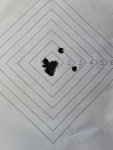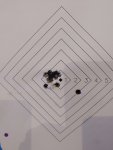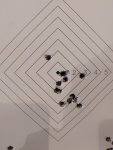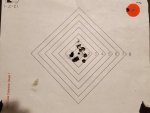I have a video, although one card was acting funky I hope I have all of it, when I went to review in the camera is showing an issue, not playing. I just got home I have to check it, but I have footage.
But I didn't "run" it like a stage, I set up at each position and shot it, of course moving from one to the other as I finished, but I took my time, which was like a minute per stage if that, it was only 3 rounds. I did not rush, I built my position and shot, then moved to the next. Like I said I might have spent a minute per position.
I have a bigger thread/article to make because I noticed something doing this, and I changed my entire zeroing and set up beforehand.
I bought the Valkyrie with me, it was a practical rifle, AX Chassis, not a lot of extras, just a Bighorn with a LH GT Bartlein, when I first addressed the rifle I didn't like the position of the scope, it needed to come one pic back to feel really comfortable in all positions. So I moved the scope and rezeroed it with 75s. I didn't like what saw with those so I switched to 88s, and was much happier with my set up going into it.
So from the beginning, I rezeroed the rifle with 88s at 100 yards, then I did a practice run on paper (dots, different target) and checked my zero. This is where it gets tricky:
So in the prone, you have one zero, in the other positions you will see an offset, so I checked it. (Nobody said there was no practice) I wanted to find my balance of zero between the positions. Which I did, it's about .2 in variation is what I saw.
I used this target to practice:
View attachment 7509206
if you look at the second target from the right, that had my final elevation on it. Just that little guy in the orange. I shot it for zero in the standing after this run. So the rifle was zeroed, I balanced that zero dialing up .1 from the center and it kept my shots tighter. More Precise on target. But I did take the time to establish all this, no rules against it.
 View attachment 7509201
View attachment 7509201
So you had one about .1 Low and then another about .1 High
View attachment 7509202
These are 3/4" dots with 3/8" orange pasty I stuck on it to see, (I added the same pasty to the Kraft target the aiming point was not comfortable for me, so I changed it. I needed a better aiming point, so once the floating dot hit the orange I was good. I actually did better shooting faster, breaking the instant the dot was centered.
If you check out my target above you see one stringing right, I found my leveling base was slipping so when I shot it for the score, I had to overtighten the tripod to keep it from tossing a round which I still did. I think my 2MOA right side flyer was the Leveling base slipping there too. As a side note, when I was all finished putting everything away I noticed my suppressor was loose too, 224 probably didn't care because it was a 30 cal can on it, but it was definitely loose.
A couple of observations:
NPA Matters, I had to make sure I broke the center of the target with my vertical reticle. Then my horizontal was set up .5 Low as my head weights .5 Mils. So that means when I address the rifle, I rise into my target, I then back off the pressure, check the reticle position, if it does not drift left or right, I was good to start.
I run about 75% of Full pressure behind the rifle in the alternate positions.
So my thinking was, zero .1 Mil high of center in the prone then my positional shots will be more in line with my prone zero. I fine-tuned it by doing a single practice run then I went live the whole thing took me maybe 4 minutes. I set up the rifle up ahead of time for this.
Basically, I settled on my zero needing to be .1 Mil high of center and .1 Mil left of center. In order to group dead center on the target as often as possible. But for sure the tripod matter, the NPA of that.
 ) and made adjustments and created a book on zero shifts based on position. Frank could you clarify, it sounded like you adjusted your rile setup and other things.
) and made adjustments and created a book on zero shifts based on position. Frank could you clarify, it sounded like you adjusted your rile setup and other things. 








